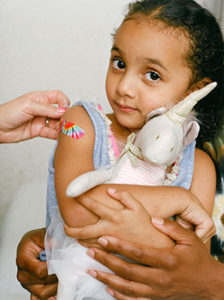
As state legislators have grappled with policies to address vaccine hesitancy, public health officials and journalists could do more to emphasize that the United States has a well-established and effective vaccine safety surveillance system, policy experts told AHCJ members during a Nov. 21 webcast.
The U.S. engages several agencies and organizations, including the Centers for Disease Control and Prevention, the U.S. Food and Drug Administration, the Health Resources and Services Administration, and the National Academy of Medicine, plus eight health care systems and seven academic hospitals in monitoring vaccine safety.
“I don’t think people realize the scope of our vaccine safety regulatory system and how extensive it is,” Dorit Reiss, professor of law and the James Edgar Hervey ’50 chair of litigation at the University of California’s Hastings College of the Law in San Francisco, told journalists during the AHCJ webcast, “Vaccines, Civil Liberties & Mandates.”
People can report adverse reactions to vaccines to the Vaccine Adverse Event Reporting Systems (VAERS) and the FDA Adverse Event Reporting System (FEARS). Both systems serve as early warning systems to help the CDC and the FDA monitor problems after a vaccine’s approval. There also is the Vaccine Safety Datalink, a collaborative between the CDC and the health systems Kaiser Permanente (covering Washington, Northwest, California and Colorado), Marshfield Clinic, Healthcare Partners and Harvard Pilgrim, where researchers proactively search for adverse responses to vaccines.
In addition, the CDC collaborates with seven hospital systems – Boston Medical Center, Cincinnati Children’s Hospital Medical Center, Columbia University, Duke University, Johns Hopkins University, Kaiser Permanente Northern California and Vanderbilt University – on the Clinical Immunization Safety Assessment Project to address vaccine safety concerns and research.
“Vaccine skeptics don’t like to talk about it, but there are things that are found, and in the rare instances there have been withdrawal of vaccines,” said Saad Omer, director, Yale Institute for Global Health, who also spoke during the webcast.
There also could be more emphasis on the harm that vaccine-preventable diseases, such measles, can cause to the body. Before the elimination of measles was declared in 2000, the virus sickened 3 million to 4 million Americans a year, resulting in 48,000 hospitalizations and 400 to 500 deaths, according to the CDC. Recent research also shows that the measles virus can cause long-term damage to children’s immune systems even after they recover from the disease.
Over the past two decades, there have been pockets of communities in the U.S., which for various reasons that have chosen not to vaccinate children or have been hesitant to do so. In 2019, there were 1,261 confirmed cases of measles in the U.S., the largest since 1992.
“We [as public health experts] tend to go down the rabbit holes of countering the information around vaccine misinformation, rather than highlighting the importance of the disease itself,” Omer said. “Diseases aren’t absent due to a celestial miracle. They can come back and they do come back if vaccine rates go down.”
Weiss and Omer were speaking about what strategies can be deployed by public health officials to communicate effectively with parents hesitant about vaccinating their children.
In 2017, 91.5 percent of children had been vaccinated against measles by the age 3, the CDC said, noting that vaccination rate should be closer to 95 percent in communities to ensure herd immunity.
After the measles outbreak in 2019, several state legislatures, including Maine, Washington, New York and California, moved to eliminate non-medical exemptions from vaccinations if parents want their children to attend public school.
Omer presented multiple studies during the webcast showing that state vaccine mandates do ensure high vaccination rates among schoolchildren. Reiss explained the legal underpinning of the state mandates, noting that the legal rights of parental autonomy are trumped by the rights of the child and the community when it comes to health.
“Parental autonomy is important, but parental rights have limits,” she said. “When it comes to childhood vaccines, the tension is between parent rights, public health and the rights of others. Since there is a good argument that the risks of vaccines are small and the benefits are large, then it is in the child’s interest to be vaccinated,” and it is in the interest of the community for children to be vaccinated.
Doug Levy, the third panelist, urged journalists to not just report on people’s fears about vaccines but also consider not quoting individuals who are expressing incorrect information about vaccines.
 “Journalists need to make sure they aren’t just quoting people but evaluating what they are saying,” said Levy, an independent journalist, former public information officer and author “The Communications Golden Hour: The Essential Guide to Public Information: When Every Minute Counts. “If someone says something factually incorrect, maybe don’t quote them.”
“Journalists need to make sure they aren’t just quoting people but evaluating what they are saying,” said Levy, an independent journalist, former public information officer and author “The Communications Golden Hour: The Essential Guide to Public Information: When Every Minute Counts. “If someone says something factually incorrect, maybe don’t quote them.”
View the AHCJ webcast here.








